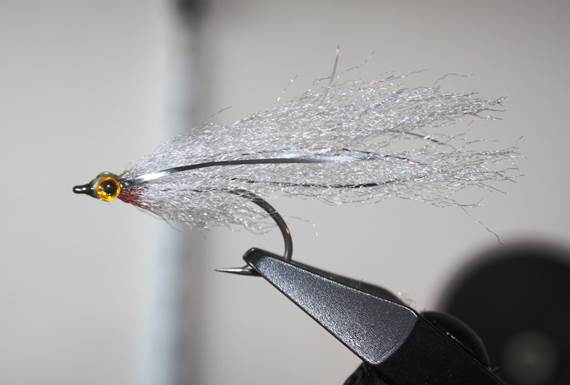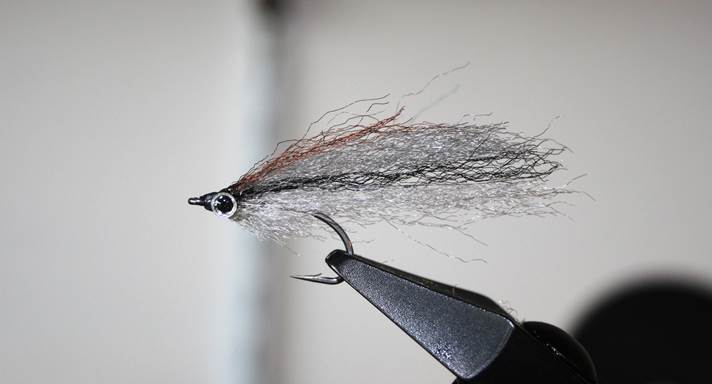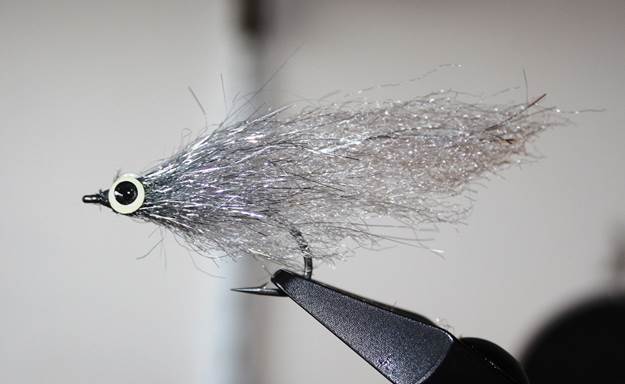SALTWATER CHRONICLES FLY FISHING ADVENTURES IN SALTWATER - Part 6
| Sysadmin Note |
|---|
| Part 5 can be found here |
BAITS PART FOUR, MINNOWS CONTINUED:
This column will be the final part of the bait minnows that have major importance to the saltwater fly angler. The minnows that I will be covering are Silversides, Anchovies, Sardines and Ballyhoo and the Glass Minnow.
Glass Minnow imitations are used to imitate the first three minnows we will be discussing. The Ballyhoo was added just to confuse you and make thing difficult because at times I just enjoy being contrary.
A friend of mine was preparing to visit me in Florida and was tying up the patterns that I had suggested since this was to be his first trip to the saltwater and he was trying to become educated on what to expect. In the course of our discussions he asked me what is a Glass Minnow and what does it represent?
He told me that he had went on the Internet and using the search engine Bing he found some 59,600 sites dealing with Glass Minnows and was a little confused to say the least. I laughed and commented that sometime saltwater fly fishing can be as confusing as trout fishing with all the various insects and fly names.
In truth, the Glass Minnow is a generic term for small silvery minnows of ¾ of inch to 2½ inches in length and is used to imitate Anchovies and Silverside Minnows, though in all reality they have come represent any small silvery minnow that is being eaten. However I can see and understand my friend being overwhelmed by the information available on line, as I use the Internet very often myself while doing research on the various subjects that I write about. I have come to realize that you cruise several sites, obtain the information, which I do by jotting down notes, and then I verify the information I have obtained with my own research library and the advice of others whom are respected authorizes on the subject I am researching. You need to stay focused on the information you are seeking. Few would have the time or the desire to go through 59,600 sites. However the Internet is a fine source to gather information and to become familiar with the area you are going to fish, just don't allow yourself to be overwhelmed by the number of sites you can encounter on any destination or subject.
The Atlantic Silverside [Menidia menidia] are minnows that range from ½ to 5½ inches long and are a translucent grey green on the back with a pale creamish color on the belly with dark brown speckles along the distinct silver bands on either side of the body, and with a thin black stripe down the center line of the body. They are also known as Green Smelt, Sand Smelt, whitebait, Capelin, Sperling and Shiners. These minnows are schooling fish and can be found along gravel or sandy shores, brackish estuaries, saltwater rivers, especially in the area of the inlets, and on the grass flat. These minnow begin to appear in mid to late march and are found in shallow water during the warmer months of the year, but as the water temperatures cool they will move into deeper water. They have a life span of 1½ to 2 years and the first spawning cycle will take place in April, however they can spawn several times in a season and do so in the shallow water.
Silversides feed on zooplankton, shrimp, amphipods, young squids, insects, worms and algae making them omnivorous feeders and in turn everything in the saltwater feeds on the Silversides and I mean everything. You encounter mixed schools of Atlantic Silverside and Inland Silverside [Menidia beryina] in the same area and they are similar in appearance.
As a point of information the Inland Silverside is used in EPA acute and chronic toxicity testing for saltwater research. The Silverside are an important minnow as they in great number and during the warm weather months the gamefish are always aware of them and preying on the bounty that nature has provided. During the months of winter this minnow is seldom seen and is of little use to the fly angler.
The next species of baitfish minnow that is often imitated with Glass Minnow imitations is the Sardines. In Florida there are four species of Sardines they are; Orange Spot Sardine [Sardinella brasiliensis] which is found in the Gulf and throughout the Keys, Redear [Harengula humeralic] which is found in the Gulf and Southeast Florida. The Scaled Sardine [Harengula jaguana] this is one of the most important of the Florida baitfish and the final species of Sardine found in Florida is the Spanish Sardine [Sardinella aurita] and this species is common along much of the east coast of Florida.
Sardines are a very popular minnow and almost all of the saltwater gamefish will actively feed on them. They are found both inshore in shallow waters and in the open ocean and they can grow to 8 inches in length and are harvested for human consumption. They have a life span of three to four years and are also referred to as Pilchards in some areas of the fishing world. This is also a schooling fish and can be found in the inlets and river mouths of saltwater rivers and out to the edge of the shelf in the open ocean. The sardines are migratory in nature and mostly spawn in the spring and summer.
The individual species have some color differences by share the same shape and general coloration. In the shallow water Sardines are often found over the edges of the grass flats around the docks and piers and hanging around the weather or channel marker buoys in small schools. Sardines feed on zooplankton, copepods and phytoplankton and they prefer water that are 75 degrees and above. With the arrival of cooler water they move south and out in a little deeper water looking for their comfort zone. In my area they show up mid to late April and begin to disappear in October, depending on the yearly weather cycle.
One of the most popular and wide spread of the baitfish in found in Florida waters is the Bay Anchovy. They are also known as bigmouth fry, fry fish, shiners and glass minnows. They range from 2 to 4 inches and have a two year life span and also feed on Plankton, copepod, isopods and small worms and fish eggs.
There are three other species of Anchovies found in Florida waters but the Bay Anchovies [Anchoa mitchilli] occur through the IRL System (Indian River System). They are like the Sardines and harvested for human consumption. Bay Anchovies are small greenish fish with a blueish hue on the back and silver stripe that runs the length of the body. They have a mouth that is blunt and it is filled with tiny sharp teeth.
One time I was with some friends who were using live bait as I was using flies and upon running out of bait we were throwing a cast net to restock their supply. After a throw and drawing the net to the deck I notice that we had picked up several Bay Anchovies, one of the anglers knelt down and pick up a few claiming he had never seen any live Bay Anchovies but as he began to examine them he suddenly flung them overboard. We all looked at him like he was crazy then he stuck out his hand and said "they bit me, I can't believe that they bit me." We in turn rolled with laughter and none present will soon forget the event. Often it is these small moments of laughter and strange events that are remembered long after the memory of the fish we caught has faded into the mist of time.
The spawning will vary according location and they do so out in the open ocean far from shore. They can be found in the coastal rivers, along the shoreline, and in brackish water and in the open ocean and they have an extremely tolerant range temperature range and can tolerant a wide range of salinities. The Bay Anchovy and its cousins are the final minnows that the many variations of the Glass Minnow is used to imitate.
Ballyhoo [Hemiramphus brasiliensis] can reach a length of sixteen inches and is very noticeable due to its long lower jaw which is 20% of the length of the body. Ballyhoo is also known as Hoo, Bally and Halfbeaks and these minnows feed on algae, sea grass, Plankton, crustaceans and small fish.
It is generally thought that Ballyhoo are found in the open ocean near the surface of the water, however ballyhoo in the three to seven inch range are often found along the shoreline and in the inlets and mouths of the costal saltwater rivers. Ballyhoo have a silver body with green and black hues on the back and it has dark fins and the Caudal Fin is orange to reddish color and the dorsal fin is set back almost to the base of the tail. They spawn during the spring and early summer and are a schooling fish with a life span of three to four years and I am told that they are edible though I admit that I have yet to try them.
Ballyhoo are taken by Tarpon, Spanish Mackerel, Dolphin, Sailfish plus many of the other saltwater gamefish will feed on Ballyhoo. For those of you who are familiar with Joe Bates volume of Streamers & Bucktails - the Big Fish Flies, then you will be able to find some of the early Halfbeak patterns.
In the future there will be one more installment dealing with baits however I am concluding the coverage of the various popular baits.
Please understand that there are a great many baits that I have not covered, as the total number of baits would really need a major volume to cover all that is available to the gamefish. Many of the smaller gamefish become prey for the larger gamefish and the saltwater is a complex predator - prey environment. In the upcoming installments I will begin to cover some of the most popular gamefish found in the area of Sebastian Inlet. With the next installment I will be covering the Glass Minnow and the history and development of this effective saltwater fly patterns and how it changed and been modified by fly tiers with different materials and new ideas.
Now we will move to the patterns that I use imitate the various minnows that I have covered in this installment.
I will make one point before I move on to the recipes and that is that the flies should be slender and can be tied in smaller sizes.

Little Silvery White Minnow
- Hook: Dai-Riki 930 Sizes: 2-8
- Thread: White 6/0
- Wing/Body: White EP Fibers with 8 strands of Silver Holographic Flash, topped with another Bunch of White EP Fibers, then place on either side a strip of wide Silver Flash-A-Bou
- Belly: White EP Fibers
- Gills: Red slash on the belly made with a Red Sharpie marker
- Eyes: 3-D Red with Black centers applied with epoxy

Anchovy Minnow
- Hook: Dai-Riki 930 Sizes: 2-8
- Thread: Light Dun 6/0
- Wing/Body: Silver/Grey EP Fibers with two strands of Silver Holographic Flash follow a very thin bunch of Black EP Fiber and then Gray EP Fibers and top with another thin bunch of 3D Brown EP Fibers
- Belly: White EP Fibers
- Eyes: 3D Silver with Black centers applied with epoxy

Silversides Minnow
- Hook: Dai-Riki 930 Sizes: 2-8
- Thread: Light Dun 6/0
- Wing/Body: Silver/Grey EP Fibers with two strands of Silver Flash-A-Bou topped with a thin bunch of Bronze EP Fibers and then another Bunch of Silver/Grey EP Fibers
- Belly: Silver/Grey EP Fibers
- Head: Silver Dubbing Brush
- Eyes: 3D-White with Black centers applied with epoxy
These patterns have worked for me, give them a try!
Enjoy & Good Fishin'
| Sysadmin Note |
|---|
| Part 7 can be found here |
